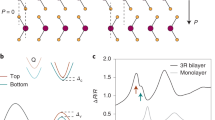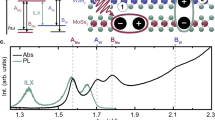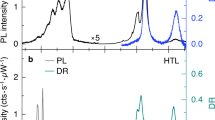Abstract
Van der Waals heterostructures have recently emerged as a new class of materials, where quantum coupling between stacked atomically thin two-dimensional layers, including graphene, hexagonal-boron nitride and transition-metal dichalcogenides (MX2), give rise to fascinating new phenomena1,2,3,4,5,6,7,8,9,10. MX2 heterostructures are particularly exciting for novel optoelectronic and photovoltaic applications, because two-dimensional MX2 monolayers can have an optical bandgap in the near-infrared to visible spectral range and exhibit extremely strong light–matter interactions2,3,11. Theory predicts that many stacked MX2 heterostructures form type II semiconductor heterojunctions that facilitate efficient electron–hole separation for light detection and harvesting12,13,14,15,16. Here, we report the first experimental observation of ultrafast charge transfer in photoexcited MoS2/WS2 heterostructures using both photoluminescence mapping and femtosecond pump–probe spectroscopy. We show that hole transfer from the MoS2 layer to the WS2 layer takes place within 50 fs after optical excitation, a remarkable rate for van der Waals coupled two-dimensional layers. Such ultrafast charge transfer in van der Waals heterostructures can enable novel two-dimensional devices for optoelectronics and light harvesting.
This is a preview of subscription content, access via your institution
Access options
Subscribe to this journal
Receive 12 print issues and online access
$259.00 per year
only $21.58 per issue
Buy this article
- Purchase on Springer Link
- Instant access to full article PDF
Prices may be subject to local taxes which are calculated during checkout




Similar content being viewed by others
References
Geim, A. K. & Grigorieva, I. V. Van der Waals heterostructures. Nature 499, 419–425 (2013).
Britnell, L. et al. Strong light–matter interactions in heterostructures of atomically thin films. Science 340, 1311–1314 (2013).
Yu, W. J. et al. Highly efficient gate-tunable photocurrent generation in vertical heterostructures of layered materials. Nature Nanotech. 8, 952–958 (2013).
Yankowitz, M. et al. Emergence of superlattice Dirac points in graphene on hexagonal boron nitride. Nature Phys. 8, 382–386 (2012).
Ponomarenko, L. a et al. Cloning of Dirac fermions in graphene superlattices. Nature 497, 594–597 (2013).
Hunt, B. et al. Massive Dirac fermions and Hofstadter butterfly in a van der Waals heterostructure. Science 340, 1427–1430 (2013).
Dean, C. R. et al. Hofstadter's butterfly and the fractal quantum Hall effect in moiré superlattices. Nature 497, 598–602 (2013).
Britnell, L. et al. Field-effect tunneling transistor based on vertical graphene heterostructures. Science 335, 947–950 (2012).
Choi, M. S. et al. Controlled charge trapping by molybdenum disulphide and graphene in ultrathin heterostructured memory devices. Nature Commun. 4, 1624 (2013).
Jones, A. M. et al. Spin–layer locking effects in optical orientation of exciton spin in bilayer WSe2 . Nature Phys. 10, 1–5 (2014).
Lopez-Sanchez, O., Lembke, D., Kayci, M., Radenovic, A. & Kis, A. Ultrasensitive photodetectors based on monolayer MoS2 . Nature Nanotech. 8, 497–501 (2013).
Gong, C. et al. Band alignment of two-dimensional transition metal dichalcogenides: application in tunnel field effect transistors. Appl. Phys. Lett. 103, 053513 (2013).
Komsa, H. & Krasheninnikov, A. Electronic structures and optical properties of realistic transition metal dichalcogenide heterostructures from first principles. Phys. Rev. B 88, 085318 (2013).
Kang, J., Tongay, S., Zhou, J., Li, J. & Wu, J. Band offsets and heterostructures of two-dimensional semiconductors. Appl. Phys. Lett. 102, 012111 (2013).
Terrones, H., López-Urías, F. & Terrones, M. Novel hetero-layered materials with tunable direct band gaps by sandwiching different metal disulfides and diselenides. Sci. Rep. 3, 1549 (2013).
Kosmider, K . & Fernandez-Rossier, J. Electronic properties of the MoS2-WS2 heterojunction. Phys. Rev. B 87, 075451 (2013).
Mak, K. F., Lee, C., Hone, J., Shan, J. & Heinz, T. F. Atomically thin MoS2: a new direct-gap semiconductor. Phys. Rev. Lett. 105, 136805 (2010).
Splendiani, A. et al. Emerging photoluminescence in monolayer MoS2 . Nano Lett. 10, 1271–1275 (2010).
Berkelbach, T. C., Hybertsen, M. S. & Reichman, D. R. Theory of neutral and charged excitons in monolayer transition metal dichalcogenides. Phys. Rev. B 88, 045318 (2013).
Qiu, D. Y., da Jornada, F. H. & Louie, S. G. Optical spectrum of MoS2: many-body effects and diversity of exciton states. Phys. Rev. Lett. 111, 216805 (2013).
Grancini, G., Maiuri, M. & Fazzi, D. Hot exciton dissociation in polymer solar cells. Nature Mater. 12, 29–33 (2013).
Jailaubekov, A. E. et al. Hot charge-transfer excitons set the time limit for charge separation at donor/acceptor interfaces in organic photovoltaics. Nature Mater. 12, 66–73 (2013).
Kaake, L. G., Moses, D. & Heeger, A. J. Coherence and uncertainty in nanostructured organic photovoltaics. J. Phys. Chem. Lett. 4, 2264–2268 (2013).
Gélinas, S. et al. Ultrafast long-range charge separation in organic semiconductor photovoltaic diodes. Science 343, 512–516 (2014).
Van der Zande, A. M. et al. Grains and grain boundaries in highly crystalline monolayer molybdenum disulphide. Nature Mater. 12, 554–561 (2013).
Zhang, Y. et al. Controlled growth of high-quality monolayer WS2 layers on sapphire and imaging its grain boundary. ACS Nano 7, 8963–8971 (2013).
Lee, C. et al. Anomalous lattice vibrations of single-and few-layer MoS2 . ACS Nano 4, 2695–2700 (2010).
Berkdemir, A. et al. Identification of individual and few layers of WS2 using Raman spectroscopy. Sci. Rep. 3, 1755 (2013).
Luo, X. et al. Effects of lower symmetry and dimensionality on Raman spectra in two-dimensional WSe2 . Phys. Rev. B 88, 195313 (2013).
Terrones, H. et al. New first order Raman-active modes in few layered transition metal dichalcogenides. Sci. Rep. 4, 4215 (2014).
Wang, F. et al. Gate-variable optical transitions in graphene. Science 320, 206–209 (2008).
Mak, K. F. et al. Measurement of the optical conductivity of graphene. Phys. Rev. Lett. 101, 196405 (2008).
Shi, H. et al. Exciton dynamics in suspended monolayer and few-layer MoS2; 2D crystals. ACS Nano 7, 1072–1080 (2013).
Zhu, X., Yang, Q. & Muntwiler, M. Charge-transfer excitons at organic semiconductor surfaces and interfaces. Acc. Chem. Res. 42, 1779–1787 (2009).
Gourmelon, E. et al. MS2 (M = W, Mo) photosensitive thin films for solar cells. Sol. Energy Mater. Sol. Cells 46, 115–121 (1997).
Ho, W., Yu, J. C., Lin, J., Yu, J. & Li, P. Preparation and photocatalytic behavior of MoS2 and WS2 nanocluster sensitized TiO2 . Langmuir 20, 5865–5869 (2004).
Acknowledgements
Optical measurements and MoS2 growth were supported by the Office of Basic Energy Science, Department of Energy (contract no. DE-SC0003949, Early Career Award; contract no. DE-AC02-05CH11231, Materials Science Division). The WS2 growth part was supported financially by the National Natural Science Foundation of China (grants nos. 51222201, 51290272) and the Ministry of Science and Technology of China (grant no. 2011CB921903). F.W. acknowledges support from a David and Lucile Packard fellowship. The authors thank K. Liu and Y. Chen for help in sample characterization and L. Ju for providing the evaporation mask.
Author information
Authors and Affiliations
Contributions
F.W. conceived and supervised the experiment. X.H., J.K. and S-F.S. carried out photoluminescence and pump–probe measurements. Y.S., S.T. and J.W. grew CVD monolayer MoS2. Y.Z. and Y.F.Z. grew CVD monolayer WS2. J.K., X.H. and S-F.S prepared the heterostructure sample. X.H., J.K., S-F.S. and C.J. performed data analysis. All authors discussed the results and wrote the manuscript.
Corresponding author
Ethics declarations
Competing interests
The authors declare no competing financial interests.
Supplementary information
Supplementary information
Supplementary Information (PDF 1186 kb)
Rights and permissions
About this article
Cite this article
Hong, X., Kim, J., Shi, SF. et al. Ultrafast charge transfer in atomically thin MoS2/WS2 heterostructures. Nature Nanotech 9, 682–686 (2014). https://doi.org/10.1038/nnano.2014.167
Received:
Accepted:
Published:
Issue Date:
DOI: https://doi.org/10.1038/nnano.2014.167
This article is cited by
-
Correlation-driven nonequilibrium exciton site transition in a WSe2/WS2 moiré supercell
Nature Communications (2024)
-
Photogating-assisted tunneling boosts the responsivity and speed of heterogeneous WSe2/Ta2NiSe5 photodetectors
Nature Communications (2024)
-
Excitonic devices based on two-dimensional transition metal dichalcogenides van der Waals heterostructures
Frontiers of Chemical Science and Engineering (2024)
-
Nonlinear optics of two-dimensional heterostructures
Frontiers of Physics (2024)
-
Ultrafast charge transfer in mixed-dimensional WO3-x nanowire/WSe2 heterostructures for attomolar-level molecular sensing
Nature Communications (2023)



